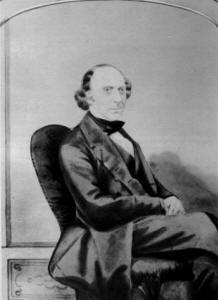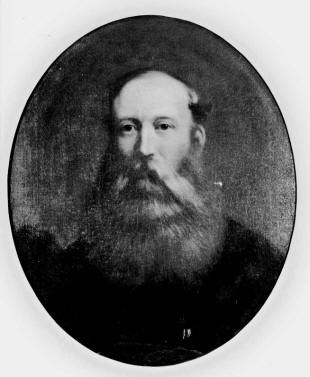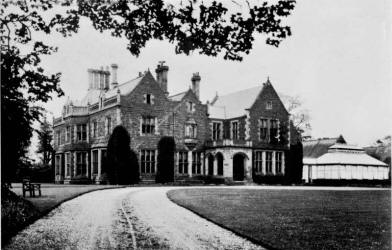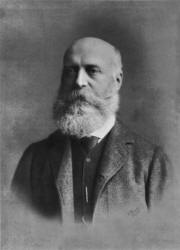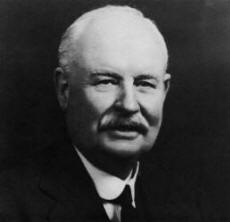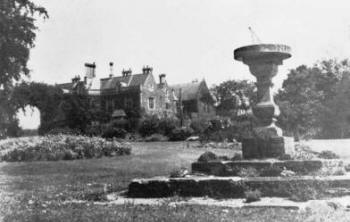
- Front Page
- Foreword
- Acknowledgements
- Contents
- Lisburn's Castle and Cathedral
- The account book of an 18th century Bishop
- An excellent new ballad
- Ballydrain, Dunmurry - an estate through the ages
- Extract from 'A Sketch of the Pelan Family'
- Michael Thomas Sadler - A Forgotten Member Of Parliament
- A Portrait John Dougherty Barbour 1824-1901
- Jigging To The Fiddle At Hilden
- Notes-"In the Gloaming"
- Newspaper Miscellanea - Shaw's Bridge a glance at it's history
- Historical Journals
BALLYDRAIN, DUNMURRY - AN ESTATE THROUGH THE AGES
BY EILEEN BLACK
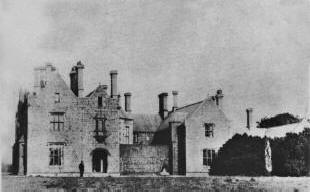 |
| Ballydrain in the late 1860s. The main entrance door is under the oriel window, in the gable wall. (Photograph courtesy of Hugh Montgomery, Benvarden, Co. Antrim). |
Ballydrain, now Malone Golf Club, is situated opposite Dixon Park,1 in area of the Lagan Valley rich with the remains of seats of Victorian Gentry. The early history of the desmesne, from the beginning of the 17th century until 1834, is bound up with that of the Stewart family. The first house to be built on the site was a bawn (or fortified farmhouse) by William Stewart, whose family was of Scottish lesser Royal blood, in 1608.2
Little tangible remains from those early days, except the family tombstones in Drumbeg Parish Church and a stone inscribed 'A Free Howse 1675' in the church porch. The tale behind the stone is a romantic one, and concerns William's son John and Anna Wilson, daughter of John Wilson, Laird of Croglin, near Dumfries. About 1640, Anna visited Ireland and on her way to Dublin, stopped at the Bell Inn, Drumbeg. It being full, she went to Ballydrain, at the innkeeper's suggestion, and was met with every kindness by the housekeeper, the owner, John Stewart, being absent. During the night, however, he returned unexpectedly, met Anna, fell in love and eventually married her. In later years, to commemorate their meeting, the couple erected a small house by the entrance to Ballydrain, with a stone inscribed 'A Free Howse 1675' over the door. The little house survived until about the beginning of the 19th century, by which time it had become something of a nuisance. After its demolition, the stone was salvaged, to become a family heirloom and is now in the care of Drumbeg Parish Church.
John Stewart died in 1691, aged sixty-nine, Anna in 1682, aged sixty-three. The property then passed to his son Thomas (1660-1715) and later, to Thomas's son John (1701-84), who married Jane Legge (1698-1778) 3 John and Jane had seven children: Elinor (1726-1806), who built her home Windsor, in Ballydrain grounds; Thomas (1728-1806), of Whitehouse; Martha (1731-58), who married Israel Young husband and had three children; William (1733-1808), builder of Wilmont,4 Alexander George (1737-96), who built himself a house, Macedon, near Whitehouse; Elizabeth Anne (b. 1737), who married Nathaniel McGee (Magee), and Robert (1749-97), who eventually became owner of Ballydrain. Robert married Mary Isabella Mitchell (1750-85) about 1767 and had five daughters and two sons, John, who died at the age of eleven, and George, who inherited Ballydrain. George married Martha Rainey and had two sons, William and Robert, both of whom died abroad in early life.5 Shortly before his death in 1805, George sold Ballydrain to his cousin, John Younghusband.6 The estate remained in Younghusband's possession until 1834, when he sold it to Hugh Montgomery for £13,500.7
The Stewarts were involved in both farming and linen, as were many other
prosperous farmers in the Lagan Valley in the late 18th and early 19th
centuries. There were bleachgreens at Ballydrain, Wilmont (in operation until
1815),8 Edenderry, Newforge, Dunmurry and Lambeg, to name but a few
areas. In addition to linen and farming, Robert of Ballydrain and William of
Wilmont were involved in the money market, being among fifteen gentlemen who
started the Belfast Discount Company in March 1793. (The company, which provided
a valuable service for merchants seeking a home where surplus cash could earn
interest, faded into insignificance before 1820). Robert, (a member of Belfast
Chamber of Commerce)9 and William each gave £300 towards the building
of the White Linenhall, in 1782. William's son John kept up the family tradition
in commerce, being one of six partners in the Belfast Commercial Bank, which
started business in 1809, with each of the partners putting £10,000 into the
firm. He resigned his partnership in 1815, however, probably because of a
disagreement with his colleagues due to the fact that he had withdrawn all his
capital and had an overdraft.10
By the mid 1830's, Stewart family influence was on the wane. Ballydrain had
finally passed out of the family's possession, with the selling of the estate to
Hugh Montgomery, and Wilmont House was decaying and lying empty after its owner
John Stewart (William's son) died issueless, in 1829. (John, something of a neer-do-well,
had gambled away his fortune. Thomas Alexander, his brother, tried to salvage
the family linen business but John's debts were. too heavy and Thomas was forced
to emigrate to Canada, in 1822)
11 Only the Stewart estates, Ballydrain and Wilmont, were to remain,
as memorials to the family's wealth and enterprise.
The Stewart home in the mid 18th century was a modest building, L-shaped and situated directly at the head of the avenue of lime trees, on the site of the present car park.12 It is possible that there was a small house on the opposite side of the lake from the main dwelling house, used exclusively for balls and entertaining, 13 a watercolour by John Nixon (active 1780), dated 1785, entitled Mr. Stewart's Ballroom near Lisburn, and showing a plain two-storeyed house beside a lake, is in the Ulster Museum.14 Considering the smallness of the main house in the 1760s, an additional venue for family entertainment in the 1780s seems feasible. A definite identity for the scene depicted in the watercolour remains uncertain; however, the lake close to Mr. Stewart's Ballroom looks decidedly like that at Ballydrain. By 1832, the family home had expanded considerably, as can be seen on the 1834 Ordnance Survey map.
There were other houses on the demesne besides the main dwelling house. Windsor,
home of Elinor Stewart, has already been mentioned.15 There was also
Lakefield, owned by Thomas .Alexander Stewart in 1819 and occupied by
Catherine Richardson in 1832.16 E. K. Proctor's Belfast Scenery in
Thirty Views, 1832, plate xxx, shows Lakefield to have been an informal Georgian
building, situated on the north side of Ballydrain Lake, facing south. The house
was later demolished (it does not appear on the 1858 Ordnance 'Suft map), and
its enclosed park absorbed into Ballydrain demesne.
![]()
The present Ballydrain House (fig. 1) is said to have been built in 1835 17 however, the Ordnance Survey Memoirs of November 1837 record that Montgomery was in the process of erecting 'a fine castle' on the estate; an indication that the house was still incomplete in 1837. The building was certainly finished by 1843, as evidenced in a survey of the estate in year, carried out by Hugh Hanna.18 Hugh Montgomery's 'fine castle' was not erected on the site of the 18th century house, but some distance north-east of this. The house was built in the Tudor Revival style, with coursed but undressed stone, tall diamond-set chimney stacks, shouldered gables and mullioned and transomed windows,19 The garden front appears to have had a central oriel window on the first floor, above double one-storeyed. bays. The architect remains unknown. Tudor Revival was introduced into Ireland after 1821 by William Vitriuvius Morrison (1794-1838), architect of Ormeau House and Glenarm Castle.20 Compared with these highly ornate examples of the style, Ballydrain before its 1876 alterations was dull, if robust.
The new owner of Ballydrain, Hugh Montgomery (1794-1867) (fig. 2) was the second son of Hugh Montgomery (1743-1832) of Benvarden, Co. Antrim, President of Belfast Chamber of Commerce 1802-03 and founder, in 1809, of Montgomery's Bank, forerunner of the Northern Bank. Like his father, Hugh sn r. of Ballydrain was involved with the Northern Bank, being a Director for fourty-three years. He and his wife, Emily Ferguson, had six sons and one daughter. After his death, on 17 June 1867, the estate became the property of his second son, John Ferguson Montgomery, (the eldest son, Hugh, having been killed in the Charge of the Light Brigade, at the Battle of Balaclava, October 1854).
John Ferguson Montgomery (1832-76) (fig. 3) was, by all accounts, a dashing figure. Nicknamed 'Rufus', on account of his red hair and beard, he was an outgoing character, cheerfully extrovert and a fearless sportsman. He was well-known in Turf circles throughout the British Isles, being familiarly called 'The Captain', a title he was permitted to use after his retirement from the Queen's Royal Antrim Rifles. His tragic early death was thee result of an accident at the Maze racecourse on 8 April 1876 when he was about to ride his horse, The Raker, in the Hillsborough Cup.21 As the race was about to start, The Raker bolted over the side rail. In his anxiety to get back into the race, which had just started, the Captain took the rail back again too short, the horse's forefeet tripped the top and both horse and rider fell, the Captain landing heavily on his head. He was carried to a nearby house, and moved next day to the Ulster Club (presumably to be close to medical facilities) where he died three weeks later, on 30 April. The Bellfast News-Letter in its obituary,22 said of him that 'His generous open-hearted disposition rendered him a universal favourite, and his name was associated with everything calculated to endear him to all who had the privilege of his acquaintance'. After his death, Ballydrain passed to his brother Thomas, Hugh Montgomery's fifth son (the third and fourth sons, Alexander Richard and James Charles having died in 1861 and 1870).23
Thomas Montgomery (1837-1909) (fig. 4) seems to have been the antithesis of his
brother John in
temperament, disapproving of the theatre, racing, gambling and anything that
smacked of 'loose living'. His grandson, Hugh Crawford, has described him as a
typically Victorian and though rather narrow minded unimaginative in outlook, a
kindly man and a devout Church-goer.24
He worked all his life in the Northern Bank, being a Director from 1867 until
his retirement in 1905. In addition, he was Deputy Lieutenant for County Antrim.
He married Isabella Walker, daughter of the Rector of Drumbeg and had six
daughters and one son, Captain Hugh Ferguson Montgomery. At the time of
inheriting the estate, Thomas and his family were living in Malone House.25
![]()
Shortly after coming into possession of Ballydrain, Thomas began a series of alterations to the house. As can be seen in fig 5, the main entrance door was moved from beneath the oriel window (as in fig. 1) and put into a projecting porch with a Tudor arch which was part of a major insertion with a dominant gable. The garden front was also altered, the first floor oriel window being removed and replaced by a central two-storeyed canter bay inserted between the one storeyed bays of the ground floor. The alterations were very well handled and gave the building a unity and clarity it had hitherto lacked. Though family tradition held the architect to be Sir Thomas Drew, the alterations were in fact the work of William Henry Lynn; a plan of the elevation of the entrance front, signed by Lynn and related to a contract for the work, signed 1 August 1876, is in the Public Record Office Northern Ireland.26 Thomas also added a conservatory (designed by James Boyd & Sons, of Paisley, in 1880) and a billiard room, that sacrosanct male domain so much a part of the Victorian country house.
Hugh Crawford has left an interesting and illuminative account of Ballydrain under his grandfather, Thomas Montgomery. The house, it seems, had fifteen bedrooms, with servants being accommodated in the attics. There was, however, only one bathroom, reserved exclusively for Thomas and his wife, and important guests; all other members of the family had to use portable hip baths. A considerable number of staff worked in the house. At the top of the hierarchy was the butler, followed by the cook, then a kitchen maid, one or two scullery maids, two housemaids and a 'between' maid, who worked in both nursery and schoolroom. Attendance at Sunday Church (Drumbeg) was compulsory for both family and staff. As with other large houses in the district, Ballydrain had its visiting day - Tuesday - when those who wished, could call for tea and entertainment. Tennis and croquet were played in summer. In winter, there was skating on the lake, a pleasure not confined solely to family and friends; both John Ferguson and Thomas threw the lake open to the public during the winter months, a magnaminous gesture recorded in both brothers' obituaries in the local press. Besides the house, there was a farmyard which kept pigs, cows and hens, a sawmill down by the Lagan (where wood from the estate was cut up into planks, for repairs, and beech logs, for firewood) and a laundry.
After Thomas Montgomery's death in 1909 (his only son, Captain Hugh Ferguson Montgomery having died in 1908) his wife Isabella lived on at Ballydrain until her death in 1917. The estate then passed to Thomas's nephew, Hugh Wyndham Montgomery, who sold it to John Barbour Morrison (fig. 6), Director of the Ulster Spinning Company, in 1918. The house was lived in until about 1940 and, like Wilmont, was occupied by the Army during World War II. On J.B. Morrison's death in November 1947, Ballydrain became the property of his son, John Maynard Morrison of Mullaghbuoy, Donaghedee and his (John Barbour's) brother, James Morrison, of Balloo, Groomsport, Co. Down. Though the land continued to be farmed, the house lay empty for several years, until the estate was purchased by Malone Golf Club in 1960. Play was commenced on the course on 2 June 1962, and the house was officially opened, as Malone Clubhouse, on 19 September of that year, by Lord Brookeborouqh Prime Minister of Northern Ireland. Thirty Captains of clubs throughout Ireland were also present at the ceremony. '
Part
of the grounds, and the house were changed considerably by the new
owners. One of the main alterations was the removal of the flower garden
(fig. 7), to make way for a car park, while the walled garden was turned
into tennis courts and a bowling green. The gate lodge at the main
entrance was also demolished. However, while the character of the estate
- with its magnificent trees and lake - has been allowed to remain
reasonably intact, this unfortunately has not been the case with the
house (fig. 8). The Tudor chimneys and balustrades have been removed, as
have the mullioned and transomed windows, and the main entrance has been
altered considerably. Such changes, albeit presumably in the interests
of functionalism, have sadly denuded Hugh Montgomery's 'fine castle' of
its character and style.
The importance of 'the big house' on the neighbouring community of
Drumbeg and surrounding district was considerable. Ballydrain, Wilmont
and Drum House (at Drumbridge) gave employment to both young and old;
domestic staff, gardeners, groundsmen and labourers were usually
recruited from the local labour force. The influence of the gentry was
all-pervasive. For example, in less affluent days, (when travel was not
so extensive as now), the grounds of Ballydrain were thrown open
annually to accommodate the 'scholars' of the local Sunday schools.
Children from Drumbeg, Dunmurry and Drumbo Parish Churches would march,
two abreast, (headed by a child carrying a union Jack and possibly
accompanied by a small band) to the estate, to spend the day in playing
and fun, under the paternal eye of the Montgomerys, who supplied cake
and lemonade. Such outings were still taking place as recently as the
1930s, a relic of the more feudal attitudes of Victorian times, when
country life was centred round the local squire. The very appearance of
Drumbeg Church owes a great deal to the Montgomery family; the splendid
archway of yews leading up to the church was planted by Thomas, and the
well-known lychgate was erected by Thomas's only sister, Ellen (Callwell),
in memory of her brother, John Ferguson Montgomery. The Drumbeg area,
now a favourite spot in the Lagan Valley Regional Park, owes much to the
three great estates close by.
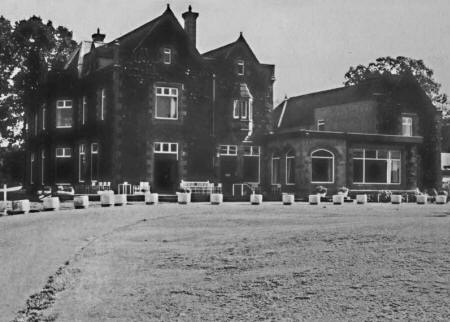 |
| Fig. 8. Ballydrain as it is now, the Clubhouse of Malone Golf Club. (Photograph - the Author). |
REFERENCES
| 1. | Formerly Wilmont, seat of Sir Thomas and Lady Edith Dixon. See my article 'Wilmont, Dunmurry: A Profile', Lisburn Historical Society journal, vol. 4, December 1982. |
| 2. | The early history of the Stewarts of Ballydrain has been recorded by Alec Wilson, in Fragments that Remain, (1950). It is, however, inaccurate in several points. Research on the family's early history is being carried out by Mrs. Rosamond Haselden, Holywood. My thanks to Mrs. Haselden and W.R.H Charley for their invaluable assistance regarding the Stewarts. |
| 3. | Stewart family dates can be found in R.S.J. Clarke, Gravestone inscriptions, Vol. 3, Co, Down, 1969, pp 29-30. |
| 4. | My article on Wilmont, loc. cit., gave c. 1740 as the year in which William Stewart built Wilmont. This is incorrect, as he was only seven years old at the time. A more likely date is c. 1760; by 1767, when his first wife died, William Stewart was established at Wilmont, as recorded in Mrs. Elizabeth Stewart's death notice, 5 June 1767. The mistaken date of 1740 originates in the ordnance survey memoirs, which state, from information supplied by local residents in 1837, that Wilmont was built 'about eighty years ago'. |
| 5. | Stewart gravestone, Drumbeg Parish Church. |
| 6. | Recorded in George Benn, History of Belfast, 1877, p. 166. |
| 7. | There is speculation on this point. Mrs. Haselden's Family History states that both George Stewart and his two sons died in Italy, and that John Younghusband acted as Trustee thereafter. George Stewart, however, died at Macedon, aged twenty-seven and was buried at Drumbeg. His young sons survived him, only to die abroad. If Benn is incorrect and George did not sell Ballydrain to Younghusband, the estate may well have passed to Younghusband, to hold as Trustee until George's sons matured. Regrettably, there is little formation about this. The lease of Ballydrain was granted to Younghusband, by the Marquess of Donegall on I June 1806 (Title Deeds kindly shown to me by present owners). |
| 8. | E.R.R. Green, The Lagan Valley, 2949, p |
| 9. | See George Chambers, Faces of Chance, 1984, for a history of Belfast Chamber of Commerce. |
| 10. | Noel Simpson, The Belfast Bank 1827-1970, 1975, contains much useful information on early Belfast banking. |
| 11. | Elizabeth Shearman Hail, A Sense of Continuity: The Stewarts of Dour This is also a useful source of Stewart family history. |
| 12. | Donegall Estate Maps, 1767-70, P.R.O.N,7., D835/1/3 |
| 13. | Wills Hill. Hart of Hillsborough (1718-93) used a Hillsborough Fort (some distance from Hillsborough Castle) as a place for balls and parties. |
| 14. | Local History Department. |
| 15. | The dates of its erection and demolition are unknown. |
| 16. | Proctor states that the occupier in 1832 was a Miss Richardson; according to the Title Deeds. however. the occupier was Catherine Richardson. The Northern Whig, 20 August 1839, records the death, at Lakefield, on 15thinst., of Louisa Richardson, youngest daughter of the late John Richardson of Summerhill Co. Fermanagh. Presumably, therefore, Catherine Richardson was the wife or daughter of John Richardson of Summerhill. |
| 17. | See Hugh Crawford, 'Ballydrain 1835-1917. A Victorian House and its family', P.R.O.N.I. , D2460/19. |
| 18. | P.R.O.N.I., D1954/6/52. |
| 19. | I am grateful to Hugh Dixon for his help regarding the architecture Ballydrain. |
| 20. | An illustration of Ormeau House appears in Proctor's Belfast Scenery, plate 1. |
| 21. | Northern Whig, 1 May 1876. |
| 22. | Belfast News-Letter, 1 May 1876 |
| 23. | Montgomery family dates can also be found in Grave Vol, 3, Co. Down. |
| 24. | See Crawford's article, n 17. |
| 25. | For a history of the house, see Malone House, U.A.H.S., 1983. |
| 26. | D1959/7/2. |

